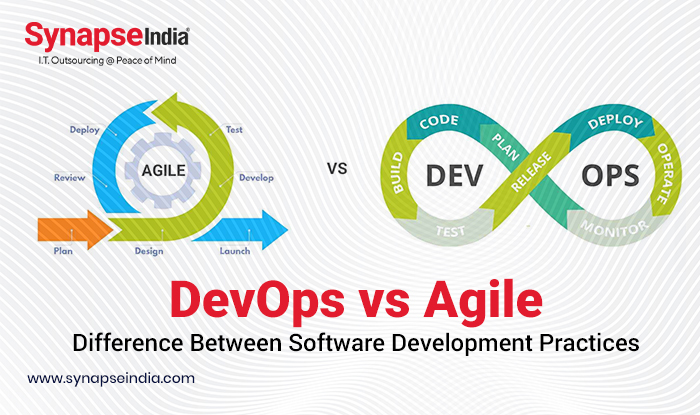 31 Jan 2024
31 Jan 2024“DevOps methodologies are a set of practices that bring together development and operations teams to streamline software development. Agile and DevOps are two popular approaches in software development.”

Over the years DevOps has evolved as a great methodology for developers. This strategy has been adopted by most companies who are looking to excel in their services. Some of the major companies that have implemented DevOps are Netflix, Etsy, Hertz, and NASA. The rise of DevOps has evolved major technologies that are looking to keep this trend, for Microsoft, and their creation of Azure DevOps which has come up with a package of great features such as Azure Boards, Azure Pipelines, Azure Repos, and many more. If you are looking for DevOps life cycleservices and other services related to DevOps, this blog will help you find DevOps, its features, and some relevant services to DevOps.

As the name suggests DevOps is a combination of Development and Operations. Microsoft describes DevOps as the union of people, processes, and technology that continues to provide value to customers. Adopting the methodology of DevOps for any team can easily be implemented and described to respond promptly to customers, as it helps to build and deploy applications quicker than ever. DevOps brings together different sets of software development best practicessuch as IT operations, development teams, security, and quality assurance to streamline operations. This allows the applications to respond quickly able to work toward a common goal.
There are many advantages associated with the DevOps life cycle, and this is the reason why many companies are adopting it. Here are the following principles of DevOps that have geared up the process of engineering:
This is a process all the code gets verified before being it to the respiratory by the developers. Also, developers can check analyze, and track the code for making better collaboration.
Daily, developers integrate the code in a shared repository. They bifurcate the code into small pieces, so it becomes easy to check it and detect bugs at an earlier stage.
When the code is integrated, it is delivered to the customers. Furthermore, through a similar process, the software development best practicescan be released to give better customer satisfaction.
While making the automation in the DevOps life cycle the speed of the development increases. Also, the continuous deployment will automate the release of the minor updates and you needn’t have any substantial threat to present the architecture.
DevOps methodology is equipped to handle testing at every stage of development. This makes valuable changes while doing the automated testing.
Developers of DevOps handle modifications and updates at every stage. Here you need to analyze and monitor the DevOps for better performance, as it sets the primary goal to prevent downtime while issuing the code.
DevOps life cycle works to foster collaboration and feedback sharing, this helps the development process to streamline and communicate with the operations in a shorter time.
The methodology of Agile focuses on constant iteration and development of the software development process. Its main goal is to have a collaborative approach and rapid release of software development best practices. Unlike the waterfall model, the development and testing iteration happens. Here the main focus is to have an evolutionary, incremental, and iterative development process. While discussing Agile and Waterfall methodology, Agile was born in the first place as an alternative to the waterfall method. In the process, the product is divided into smaller pieces, after they get integrated into final testing.
DataOps is a methodology of the development process that combines the process of tools to continuously provide quality data products and analytics within the time and predictable cost. It does not include data and operations but a set of processes that aims to continuously provide pipelines, products, and analytics, to maintain the time of delivery. It differs from the other two methodologies as data development is different from software development. Data development is about deriving insight from the data that is created by the business processes and applications.
Above we have studied a few pointers on DevOps and other similar technologies. Let’s get some technical expertise and the differences between Agile vs DevOps, and DataOps.
| Aspect | DevOps | Agile | DataOps |
|---|---|---|---|
| Focus | Collaboration between development and operations teams | Emphasize iterative development, collaboration, and quick adaptation | Integration of data engineering, data integration, and data quality practices |
| Primary Goal | Faster delivery, continuous integration, and continuous deployment. | Rapid responding to changing requirements, and delivering customer value. | End-to-end data lifecycle, ensuring data quality, and faster delivery. |
| Workflow | Involves development, testing, deployment, and monitoring | Iterative cycles of planning, coding, testing, and collaboration with customers. | Data engineering, data integration, data quality, and data governance practices. |
| Communication | Open communication and collaboration | Daily communication, face-to-face interactions, and collaboration | Collaboration between data engineers and data scientists |
| Feedback Loop | Feedback loops for developers and operations teams | Feedback from customers and stakeholders | Feedback loops for data quality, data integration, and overall data |
| Release Frequency | Frequent releases with CI and CP | Regular releases at the end of each iteration or sprint. | CI and delivery of data pipelines and data-related processes. |
| Adaptability | Adapting to changes in software requirements, infrastructure, and user needs | Adaptability to change customer requirements and market conditions | Adapts to changes in data sources and business requirements |
| Roles and Responsibilities | Collaboration among development and operations | Cross-functional teams with roles like product owner, scrum master, and development team members. | Collaborative roles of data engineers, scientists, and analysts |

Goal: The DevOps life cycleaims to streamline collaboration between development and operations teams to enhance software delivery, deployment, and overall IT efficiency.
Goal: Agile methodologies focus on delivering customer value through iterative and incremental development, fostering flexibility and responsiveness to changing requirements.
Goal: DataOps aims to streamline and automate data management processes, ensuring the efficient flow of high-quality data for analytics and decision-making.
While DevOps and Agile are more traditionally associated with software development and IT operations, DataOps specifically addresses the challenges of managing and optimizing data workflows. The practices within each approach are designed to align with the goals and priorities of their respective domains, ultimately aiming to deliver high-quality oftware development best practicesor data-driven insights efficiently.
In every way, the DevOps life cycle stands as the most mature development approach. Well, both Agile and DevOps define the way to get separated- out of the waterfall style of development. This idea of shifting left refers to both disciplines, in which each practice is associated with later parts of the waterfall process and considered at the previous stages in an Agile and DevOps process.
On the other hand, DataOps is different as it is majorly used to streamline and automate data management processes. However, Agile emphasizes interactive and customer-centric development, which breaks down the development process into short iterations. It promotes the collaboration of cross-functional terms, continuous feedback, and adaptive learning to meet customers. DevOps life cycle emphasizes CI and CD and practices automotive practices of building, testing, and deployment of software. Both of them focus on customer and team collaboration which makes them highly collaborative approaches to software development and delivery process.

.png)
 12 Feb 2025
12 Feb 2025
